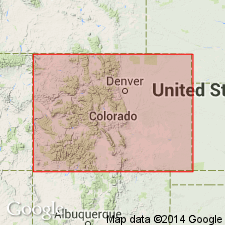
- Usage in publication:
-
- Jack's Cabin Limestone Member
- Modifications:
-
- Named
- Dominant lithology:
-
- Limestone
- Siltstone
- Arkose
- AAPG geologic province:
-
- Eagle basin
Summary:
Pg. 209-243. Named proposed for the most persistent member (of 5) of the Gothic Formation. At type locality consists of gray argillaceous to silty limestone, gray to olive very calcareous siltstone, and gray-brown to yellow-brown fine- to coarse-arkose; 34 feet [10 m] thick. Overlies Hot Springs Conglomerate Member (new) of Gothic; underlies Maroon Formation [underlies unnamed part of Gothic?]. Contains fusulinid fossils. Age is [Middle] Pennsylvanian (Desmoinesian). Report includes cross section.
Type locality: HG measured section, in sec. 21, T. 15 S., R. 84 W., few 100 m northwest of Colorado Highway 306 up first draw east of Jack's Cabin cutoff road and prominent hogback of Entrada Sandstone, Gunnison Co. [Pitkin Co.?], CO (Eagle basin). Named from community of Jack's Cabin.
[Discrepancy: US geologic names lexicon (USGS Bull. 1520) indicates Jack's Cabin Member underlies Maroon Formation and type locality is in Gunnison Co. GNU records (USGS DDS-6; Denver GNULEX) indicate Jack's Cabin Member underlies unnamed part of Gothic Formation and type locality is in Pitkin Co. --unresolved.]
Source: GNU records (USGS DDS-6; Denver GNULEX); US geologic names lexicon (USGS Bull. 1520, p. 152).
For more information, please contact Nancy Stamm, Geologic Names Committee Secretary.
Asterisk (*) indicates published by U.S. Geological Survey authors.
"No current usage" (†) implies that a name has been abandoned or has fallen into disuse. Former usage and, if known, replacement name given in parentheses ( ).
Slash (/) indicates name conflicts with nomenclatural guidelines (CSN, 1933; ACSN, 1961, 1970; NACSN, 1983, 2005, 2021). May be explained within brackets ([ ]).

